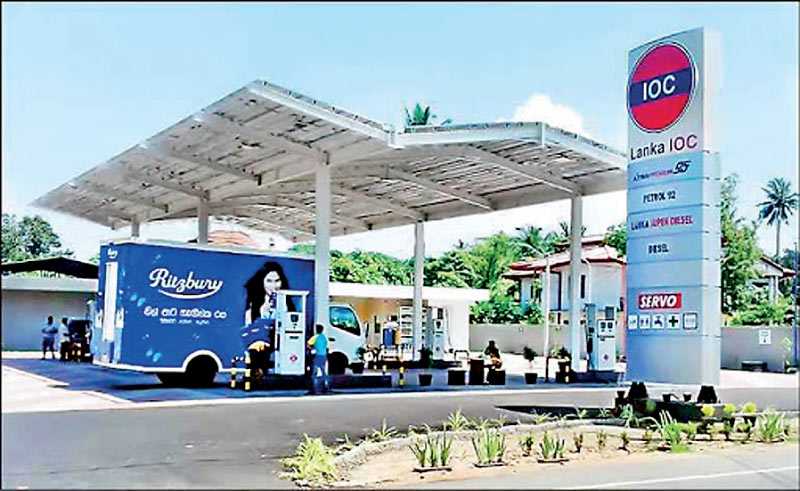Monday Apr 07, 2025
Monday Apr 07, 2025
Thursday, 4 March 2021 03:26 - - {{hitsCtrl.values.hits}}

Rising global fuel prices expected to drive up Sri Lanka’s import bill leading to currency pressures
Reversal of global commodity prices will cause a multipronged impact on Sri Lanka’s economy, exerting currency pressures due to a higher import bill, stressing finances of utility companies and have cascading effects on most sectors leading to price revisions and inflation, a report said yesterday.
ICRA Lanka, which is a subsidiary of Moody’s Investor Services, releasing their latest Insights report warned that with gradual recovery of economic activities, a rise in domestic demand for oil is likely to increase the import bill and thereby can inflict further pressure on the currency.
The report highlighted a range of consequences including an increase in petroleum prices that will exert stress on the financial position of utility companies in the short run.
It warned energy price revision may have a cascading effect on many sectors of the economy. Most importantly, it could trigger a broad-based rise in general price levels.
Sri Lanka’s agriculture sector, which employs about 27% of the workforce, will be hard hit with local farmers set to experience about 3-4% increases in costs of fertilisers in 2021. Tea, rubber, and coconut are projected to have healthy demand through 2021 but, though rubber prices are expected to maintain the momentum, tea price may grow only by about 1% in 2021, ICRA Lanka added.
Agriculture sector also consumes a substantial amount of imported intermediate goods such as fertilisers ($ 221 million in 2019) and wheat and maize ($ 346 million). Local farmers are set to experience about 1-4% increase in costs of the aforementioned inputs in 2021.
“Downstream sector products such as kerosene, heating oil, fuel oils, lubricants, waxes, asphalt, and other petrochemicals would also revise prices affecting multitude of industries.”
However, many large-scale construction contractors are less likely to experience margin erosions due to raw material price increases. However, small-to-medium scale contractors who generally enter into fixed price contracts, may have to absorb some losses.
When the global metal prices collapsed in 1Q 2020, the local importers did not drop the prices but in fact increased due to import restrictions. Hence, they may have developed some loss absorbing capacity to hold the prices in the medium term.
Last year marked the lowest commodity prices in history and Sri Lanka was able to exploit the low oil prices, amidst weaker domestic demand to ease some pressure off the rupee by cutting the petroleum import costs by around 30% in 2020 compared to 2019. Nevertheless, with commodity prices set to increase in 2021, Sri Lanka may face challenges in several fronts.
“With the imposition of import restrictions, the current account deficit has narrowed by about $ 4 billion in 2020. Sri Lanka imports around $ 20 billion worth of goods per annum. Intermediate goods, including petroleum and related products, metals, fertilisers and chemicals which are essentially inputs for domestic industries account for more than 50% of the country’s import bill.”
Sri Lanka imported around 13.5 million barrels of crude oil (20% of the total import bill) worth around $ 3.9 billion in 2019 and the decline in global oil prices coupled with slump in domestic consumption helped to save around $ 1.3 billion in 2020. As per the procurement plan of the CPC for 2021, cost of imports of crude oil and refined products is projected to be $ 2.5 billion roughly benchmarking $ 59 a barrel of crude oil.
However, OPEC’s intention to cut output in February and March this year has lifted prices above $ 60 a barrel for the first time in over a year. The rapid economic recovery of China is also keeping the oil prices buoyant. Goldman Sachs predicts brent crude oil prices to hit $ 65 a barrel during the year while the US Energy.
With gradual recovery of economic activities, a rise in domestic demand for oil is likely to increase the import bill and thereby can inflict further pressure on the currency. In addition, increase in petroleum prices will exert stress on the financial position of utility companies in the short run.
Energy price revision may have a cascading effect on many sectors of the economy. Most importantly, it could trigger a broad-based rise in general price levels.
Furthermore, downstream sector products such as kerosene, heating oil, fuel oils, lubricants, waxes, asphalt, and other petrochemicals would also revise prices affecting multitude of industries.
Information Administration (EIA) expects a lower $ 55 a barrel stemming from slowing pace of global oil inventory withdrawals.
Base metal markets are expected to return to normalcy in 2021 supported by the increase in investment expenditure by governments around the world and recovering global industrial activity. As per the forecasts copper, aluminium, and iron ore – key industrial metals – will see their prices increasing by around 14-16% this year.
Sri Lanka imported around $ 563 million worth of base metals in 2019. Rising industrial metal prices poses several implications especially for the construction industry. Item rated contracts have provisions that would enable the construction companies to claim raw material cost increases based on the monthly published price indexes.
Therefore, many large-scale construction contractors are less likely to experience margin erosions due to raw material price increases. However, small-to-medium scale contractors who generally enter into fixed price contracts, may have to absorb some losses.
When the global metal prices collapsed in 1Q 2020, the local importers did not drop the prices but in fact, increased due to import restrictions. Hence, they may have developed some loss absorbing capacity to hold the prices in the medium term.
